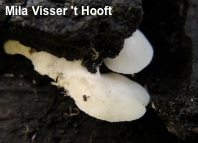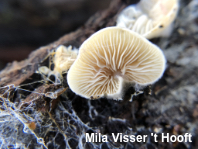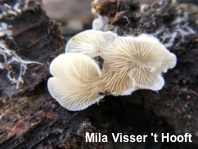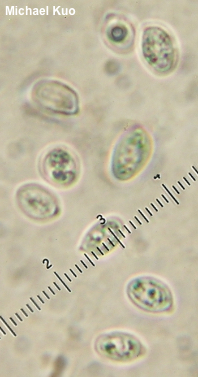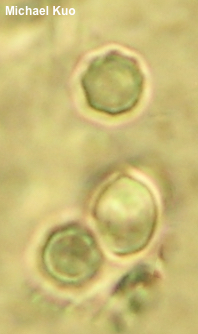| Major Groups > Gilled Mushrooms > Pink-Spored > Entolomatoid Mushrooms / Pleurotoid Mushrooms > Clitopilus hobsonii |

|
Clitopilus hobsonii [Basidiomycota > Agaricales > Entolomataceae > Clitopilus . . . ] by Michael Kuo Clitopilus hobsonii is a tiny white mushroom, usually pleurotoid in shape, growing on deadwood, grasses, or plant stems. Its gills turn pinkish with age and, under the microscope, its spores are ridged—although the ridges are very difficult to see and show up best when spores are viewed from the end. As it is currently defined Clitopilus hobsonii is found in many places across the globe, from tropical to temperate and even boreal areas. Many species of Crepidotus can look similar, but have gills that eventually turn brownish to brown. Clitopilus scyphoides is similar but grows from the ground and features a fairly well-developed stem. Clitopilus daamsii (putatively separated by its larger spores) and Clitopilus rhodophyllus (larger, with caps up to 45 mm across) may or may not represent separate species. Thanks to Mila Visser 't Hooft for documenting, collecting, and preserving Clitopilus hobsonii for study; her collection is deposited in The Herbarium of Michael Kuo. Description: Ecology: Saprobic; growing alone or gregariously on various plant substrates, including deadwood, bark, grasses, and plant stems; summer and fall, or over winter in warm climates; originally described from England, and found throughout Europe; in North America found east of the Great Plains and on the West Coast; also found in Oceania, Central America, and South America. The illustrated and described collection is from California. Cap: 5–15 mm across; in outline semicircular to somewhat irregularly shaped; planoconvex; finely silky or nearly bald toward the margin, but velvety to thickly fuzzy near the point of attachment to the substrate; watery whitish. Gills: Close or nearly distant; short-gills frequent; whitish. Stem: Absent. Flesh: Insubstantial; white; unchanging when sliced. Odor and Taste: Not distinctive. Spore Print: Pinkish. Microscopic Features: Spores 5–7 x 3–5 µm; ellipsoid; ridged longitudinally (but appearing nearly smooth in side view); angular in end view; hyaline in KOH; inamyloid. Basidia 25 x 6 µm; clavate; 4-sterigmate. Cystidia not found. Pileipellis a tightly packed cutis of elements 2–3 µm wide, smooth, hyaline in KOH; with occasional exserted, cystidioid terminal cells. Clamp connections not found. REFERENCES: (M. J. Berkeley & C. E. Broome, 1860) P. D. Orton, 1960. (Noordeloos, 1988; Breitenbach & Kränzlin, 1995; Baroni & Halling, 2000; Buczacki et al., 2012; Garnier-Delcourt et al., 2012; Siegel & Schwarz, 2016; Noordeloos, 2018; Læssøe & Petersen, 2019; Baroni et al., 2020; Jian et al., 2020.) Herb. Kuo 01262003. This site contains no information about the edibility or toxicity of mushrooms. |
© MushroomExpert.Com |
|
Cite this page as: Kuo, M. (2020, December). Clitopilus hobsonii. Retrieved from the MushroomExpert.Com Web site: http://www.mushroomexpert.com/clitopilus_hobsonii.html |
